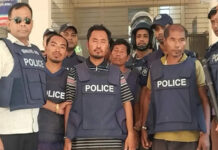Nurunnahar Begum is 62.
She and her family of eight have been living in Horinkhola Government Primary School, also used as a cyclone centre, in Koyra upazila’s Dakkhin Bedkashi for two months now.
Her home along with all her belongings were washed away on the fateful night of May 20, when the embankment along the Kopotakkho river broke at several points due to the impact of Cyclone Amphan.
Later, temporary earthen dykes, known as ring dams, were built further inland from the original embankment as the river water did not recede.
More than 100 acres of agricultural land, fish enclosure and homestead, like that of Nurunnahar’s home in Horinkhola village, fell on the river’s side of the ring dams.
“I do not know when I will be able to leave the cyclone centre. Amphan hit nearly two months ago but we could not return home,” said Nurunnahar.
Jamir Hossain, a student of Khulna Government BL College, is another cyclone victim living with his family at the Horinkhola shelter.
His family properties including three houses, five bighas of cropland and three bighas of fishing enclosure fell outside a ring dam.
“Aman and Boro paddy were cultivated once a year in our land. After covering the family’s food for the year, we could sell the rest,” he said.
“Now we have to depend on our relatives’ assistance.”
SM Sofiqul Islam, chairman of Koyra upazila, said yesterday that over 150 families are living in the Horinkhola shelter and Bedkashi Collegiate School shelter in Uttor Bedkashi.
Some families, whose homes were damaged but not lost, are also staying at the shelters while repairing their houses, he added.
Last week on July 11, this correspondent visited the two cyclone shelters.
Around 200 people of 41 families live on the first and second floor of the three-storey Horinkhola shelter.
Each room is occupied by about five to six families who used bedsheets and sarees to separate private spaces.
Needless to say, social distancing was absent in the crowded rooms of both the shelters.
None were wearing any face mask for coronavirus prevention.
The ground floor and the school premises were being used for keeping cattle and drying fishing nets.
Riyasad, a resident of the Horinkhola shelter, said most people in this area were farm or day labourers. They became jobless after Amphan.
“Now most of us catch fish in the river, eat some and sell the rest to buy rice for the family,” he said.
Chairman Sofiqul said till date, the government distributed some cash and 10 to 20 kilograms of rice eight times among the ultra poor, who took refuge on the dry part of the embankments and in cyclone shelters.
Besides, some NGOs come and distribute relief regularly among these families, he added.
Local lawmaker Md Akhtaruzzaman Babu told The Daily Star on July 15, “The government has taken four projects of total Tk 8,000 crore to build sustainable embankments in the coastal areas. The work of the project will start in the current year and will take about two to three years to complete.”
In the 1960s, embankments were constructed along river channels in the country’s coastal region to enclose low-lying tracts of land, turning the areas into polders.
The embankments have gates to control the inflow and outflow of water inside the polders.
There are about 40 such polders in Khulna, Satkhira and Bagerhat districts. Koyra falls under polder 13/4 and 14/2.
Lawmaker Md Akhtaruzzaman said Tk 957.38 crore has been allocated for repairing the embankments of the Koyra polders.
Once built properly, it will solve the current dire crisis, he said.
“We will also make a list of the people, whose homestead and properties are outside the ring dams, and take initiatives for their rehabilitation,” he added.
According to the Koyra upazila administration, over 1.5 lakh people were affected by floodwaters while 36,000 houses were partially and completely destroyed, 3,000 hectares of cropland damaged and 4,000 hectares of fishing enclosures submerged.










